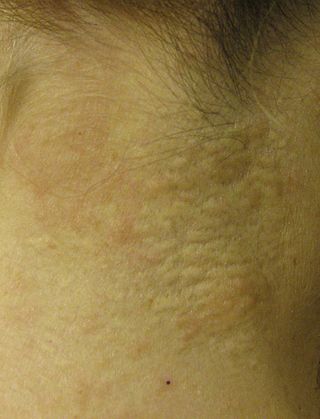
Pseudoxanthoma elasticum (PXE) is a genetic disease that causes mineralization of elastic fibers in some tissues. The most common problems arise in the skin and eyes, and later in blood vessels in the form of premature atherosclerosis. PXE is caused by autosomal recessive mutations in the ABCC6 gene on the short arm of chromosome 16 (16p13.1).

ATP-binding cassette sub-family C member 4 (ABCC4), also known as the multidrug resistance-associated protein 4 (MRP4) or multi-specific organic anion transporter B (MOAT-B), is a protein that in humans is encoded by the ABCC4 gene.

The ATP-binding cassette 4 gene encodes the Multidrug resistance protein 3. ABCB4 is associated with progressive familial intrahepatic cholestasis type 3 and intrahepatic cholestasis of pregnancy.

Multidrug resistance-associated protein 1 (MRP1) is a protein that in humans is encoded by the ABCC1 gene.

ATP-binding cassette transporter sub-family C member 8 is a protein that in humans is encoded by the ABCC8 gene. ABCC8 orthologs have been identified in all mammals for which complete genome data are available.

Multidrug resistance-associated protein 2 (MRP2) also called canalicular multispecific organic anion transporter 1 (cMOAT) or ATP-binding cassette sub-family C member 2 (ABCC2) is a protein that in humans is encoded by the ABCC2 gene.

Canalicular multispecific organic anion transporter 2 is a protein that in humans is encoded by the ABCC3 gene.

Multidrug resistance-associated protein 5 is a protein that in humans is encoded by the ABCC5 gene.

ATP-binding cassette transporter sub-family C member 11, also MRP8 is a membrane transporter that exports certain molecules from inside a cell. It is a protein that in humans is encoded by gene ABCC11.

ATP-binding cassette sub-family A member 3 is a protein that in humans is encoded by the ABCA3 gene.

ATP-binding cassette sub-family B member 7, mitochondrial is a protein that in humans is encoded by the ABCB7 gene.

ATP-binding cassette super-family B member 6, mitochondrial is a protein that in humans is encoded by the ABCB6 gene.

ATP-binding cassette sub-family F member 1 is a protein that in humans is encoded by the ABCF1 gene.

Nodal modulator 1 is a protein that in humans is encoded by the NOMO1 gene.

Multidrug resistance-associated protein 7 is a protein that in humans is encoded by the ABCC10 gene.

TAP2 is a gene in humans that encodes the protein Antigen peptide transporter 2.

ATP-binding cassette sub-family B member 8, mitochondrial is a protein that in humans is encoded by the ABCB8 gene.

Putative ATP-binding cassette transporter sub-family C member 13 is a protein that is not present in humans. In humans, ABCC13 is a pseudogene.

Multidrug resistance-associated protein 9 is a protein that in humans is encoded by the ABCC12 gene.

ATP-binding cassette, sub-family C member 9 (ABCC9) also known as sulfonylurea receptor 2 (SUR2) is an ATP-binding cassette transporter that in humans is encoded by the ABCC9 gene.

















